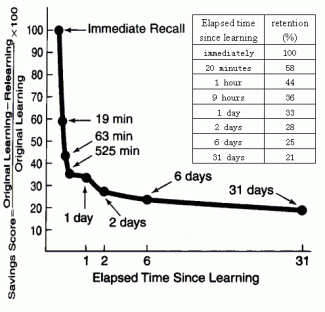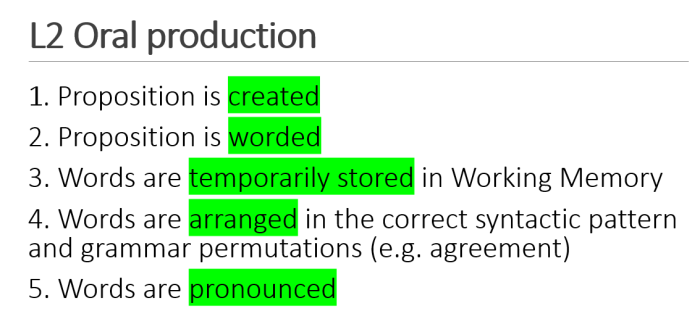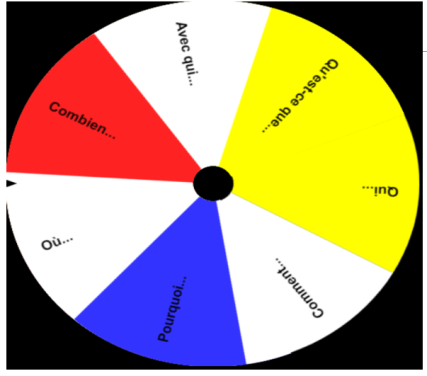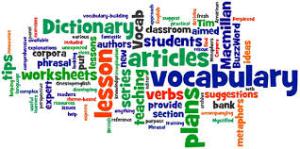1. Too much zooming in not enough zooming out
The acquisition of a phoneme, lexical item, grammar structure or learning strategy is a very long and painstaking process involving lots of exposure and practice and much trial and error that may last months or even years. Moreover, a big obstacle to long-term retention is the fact that the human brain forgets at a ridiculously high rate; 42 % of what we learn is usually lost within 20 minutes from first memorizing it, 64 % after 9 hours and 80 % after one week without consolidation (see figure 1 below)
Figure 1 – Rate of human forgetting

Hence, medium and long-term planning are more important, in the greater scheme of things, than short-term planning – what is the point in teaching ten new lexical items on Monday in the perfect lesson, if on Friday nearly eight of them will have been forgotten?
Yet, it is not uncommon for teachers to focus mostly on the here-and-now, to ‘zoom in’ without ‘zooming out’; new items are taught, the instructor dwells on them for two or three lessons, then moves on after being satisfied through a test (usually done in writing) that most of the students have ‘learnt’ them.
The bigger picture, the long-term planning in those schemes of work that very few of us look at in their daily practice, is what matters the most if we want long-term retention to happen.
The most important part of a lesson, any lesson, is the bit in which you set out what you intend the students to be able to do with the content of that lesson in the long term (e.g. receptive and/or productive mastery?) by when (e.g. the end of the year?) and think about how you are going to get there from the end of that lesson onwards.
2. Insufficient ‘horizontal’ progression
In ‘The Language Teacher Toolkit’, Steve Smith and I draw a distinction between ‘vertical’ and ‘horizontal’ progression in lessons. The former refers to progression from a lower level of language complexity to a higher one, whilst the latter refers to progression in terms of speed and control (e.g. I can produce language faster and with fewer mistakes at time 2 than at time 1).
If we do endorse, as I do, the equation Learning = Automaticity, then horizontal progression across all four skills (each skill involving different processes) should really take priority over vertical progression in lessons as well as throughout the whole of the academic year. Hence, vertical progression should only be attempted once much horizontal progression has been achieved. E.g.: no point teaching students how to form complex sentences in French, Spanish or Italian if they have not automatized how to use basic verb forms, articles or make noun and adjective agree, right?
Yet, how many of us venture into teaching more complex grammatical or syntactic structures without having ensured that the basic ones have been automatized (100 % accuracy) or at least routinized (80 % accuracy) thereby seriously damaging our students’ learning? How many of our Advanced level students of French, Spanish and German still struggle with adjectival agreement, gender and number of nouns, verb conjugation and word order in year 13?
Horizontal progression is the most neglected aspect of language teaching and learning, because it ‘slows down’ the coverage of the syllabus and requires extra resources. But when it comes to horizontal progression, less is more – is it better to teach ten grammar items in year 7 ‘superficially’, knowing that you will have to re-teach them over and over again all the way to year 11, or cut down coverage by half (as I have done) so that routinization will actually happen the first time around thanks to extensive exposure and usage?
Figure 2 – Less is more when it comes to curriculum design

In my approach, the teacher selects only a few core grammar structures per year and tracks down their level of routinization throughout the year through low-stake assessments, some given as homework (e.g. a student records himself as he describes a picture under time constraints).
The pace dictated by textbooks, one unit every six weeks is unrealistic and unfair to our students. Only few of them can cope and we end up teaching to those few if we keep to this pace. No wonder only those few choose to pursue Modern Languages beyond GCSE.
3.Five common recycling mistakes
Many of us recycle systematically and extensively across units. Many more don’t – their curriculum design does not make explicit provision for recycling opportunities of old material across new units and topics are ‘compartmentalised’ so to speak. But even those who recycle often make the following very common ‘mistakes’.
Mistake 1 – Vocabulary and grammar are often recycled using digital tools such as Memrise and Quizlets or other resources (e.g. Powerpoints or textbooks) which practise vocabulary in the very same phrases/sentences or context in which they were originally learnt. Recycling, though, is most effective when the to-be-consolidated vocabulary is ‘hooked’ (possibly through semantic processing) to an increasingly wider range of contexts, be these words, images, sounds or tasks. So, re-using the same set of Quizlet, Memrise or Linguascope activities does not constitute effective recycling because it limits the range of retrieval cues available to the learner at recall. In simpler words: consolidating the word ‘plage’ using the same sentence ‘je vais à la plage’ is going to be much less conducive to retention than recycling it through a wide range of contexts (e.g. ‘je suis à la plage’, ‘il y a une belle plage près de chez moi’, ‘la plage est bondèe’, ‘j’habite près de la plage’, etc.) because associating 5 contexts to that word offers working memory a wider range of retrieval paths and consequently more chances of successful recall.
Mistake 2: words are often recycled in isolation, which is ineffective for the same reason discussed above: learning is more effective when an item is processed in association with a wide range of other items or linguistic contexts.
Mistake 3 : the target vocabulary and grammar – especially the latter – are rarely recycled across all four skills, listening and speaking tending to be the most neglected.
Mistake 4 : homework is rarely used to recycle old material, yet there are many minimal-preparation tasks that one can set for out-of-school assignments to effectively serve that purpose. Projects to be carried out exclusively as homework are one of them.
Mistake 5 : We tend to recycle items that we teach explicitly (i.e. by explaining the rules governing their usage). But why not recycling systematically and consciously items that we don’t actually teach explicitly, but we would like our students to pick up implicitly? Which brings me to the next point.
4.Over-emphasis on explicit learning
Not all classroom learning must occur explicitly. Much research shows that masses of exposure to highly patterned, repetitive comprehensible input (i.e. 90-95 % accessible in meaning without extratextual help) can bring about learning. Hence, a big chunk of teaching and learning in the modern language classroom can and should occur implicitly.
As an example, at the beginning of every lesson I teach, as I call the register, I ask the students to tell me how they feel using the vocabulary in the table below which I project on the screen and they have in their books. By staging this activity every day, after a few weeks, the students not only learn all the vocabulary in the table without any explicit teaching, but often even internalize the basic rule of adjectival agreement in French (‘add ‘e’ to the end of the adjective with feminine nouns’) by mere usage and/or exposure.
Figure 2 – Taking the emotional temperature (daily lesson starter)

Also, at the end of lessons, as an ‘exit ticket’, I usually ask my students to tell me, write on mini-whiteboards or discuss with their classmates 4 or 5 things they are going to do after school or at the weekend, using the immediate future (‘je vais + infinitive’ in French or ‘voy a + infinitive’ in Spanish) which is modelled on a scaffolding sheet that I project on the interactive whiteboard. Again, after a few weeks, with no explanation, they usually grasp implicitly and effortlessly how to use that tense merely through repeated usage.
After delivering countless workshops on how to embed implicit learning in the curriculum it has become apparent to me that, at least in British schools, most teachers do not have a principled approach to implicit teaching. Yet, implicit learning through frequent exposure and usage, when carefully and methodically planned and implemented can yield amazing results.
5.Too much single-word teaching
As I repeat ad nauseam in my blogs (e.g. here) , teaching single words is less effective than teaching them through functional chunks, i.e. phrases used in the performance of communicative functions (list of communicative functions, here). Why? Firstly, because our brain’s working memory can only process 4 items at any one time, so better learning four items consisting of chunks of three or four words than four items consisting of one, as this will result in less cognitive effort when creating sentences. Think of the processes involved in creating and uttering a sentence (listed in the figure below), how cumbersome it can be to a novice as s/he executes each stage using single words.
Figure 4 – Oral production of a sentence

Secondly, learning vocabulary through chunks can avoid a series of commonly made mistakes if it is done smartly. For instance, when teaching clothes, teaching ‘J’ai une chemise verte’ (I have a green shirt) and ‘j’ai un blouson vert (I have a green coat), rather than simply teaching the noun preceded by the determiner (i.e. ‘une chemise’ or ‘un blouson’), as books usually do, means that (a) you teach more vocabulary in one go and (b) that you do not have to teach noun-to-adjective agreement explicitly, thereby reducing the chances of the students making mistakes in handling that structure for many years to come – as they commonly do.
Thirdly, it is evident from research that advanced learners and native speakers produce language in the attainment of a communicative goal through the execution of specific speech routines which consists of chunks of language that they piece together at high speed. Hence, chunking should be actively fostered in the foreign language classroom.
6.Cognitively overloading students
In my latest round of workshops in England, a few weeks ago, I made the attendees experience cognitive overload in attempting to memorize Japanese or Malay numbers from 1 to 10. It was a frustrating but eye-opening experience, as they experienced what their students often go through in their lessons.
If our brains can only contain four items at any one time and we are not teaching them chunks, imagine how hard it must be for a beginner to keep a sentence as long as six or seven words in their Working Memory whilst making adjectives and nouns agree with one another, conjugating verbs, getting the word order right etc. This is one common cause of cognitive overload (C0) and the main reason why you should teach chunks rather than single words.
Other very common causes of CO involve:
- receptive tasks which involve input which is not comprehensible input (i.e. less than 90% of it is accessible without resorting to extratextual help);
- comprehension questions on aural texts delivered at high speed;
- tasks which cause anxiety and stress (two strong inhibitors of Working Memory performance);
- having to attend to several tasks at the same time, e.g. when we ask our students to peer assess speaking performance with a multi-trait rubric which includes several items to feedback on (e.g. use of tenses, range of vocabulary, pronunciation, etc.)
7. Over-reliance on shallow processing
The ability to recall a specific lexical item is not simply a function of the power law of practice but also of how many associations it has with other lexical items and information in long-term memory, as well as how strong those association are. Moreover, retention will be stronger when the cognitive and emotional investment of the learner is deeper.
Hence vocabulary teaching activities should involve mostly meaning-based associations, sorting and classifying, problem solving, creativity with the language and any other task which is about deep processing. Yet, a lot of vocabulary teaching is about shallow processing, that is, mere repetition, without much involvement of higher order thinking skills, which usually creates a weaker memory trace.
8.Vocabulary, communicative functions and grammar are not usually taught across all four skills
Listening, Speaking, Reading and Writing are four different skills which involve four different sets of processes and micro-skills. Hence the use of the target lexical items, grammar structures and functions need to be acquired by our students across four skills, not just one or two, as it usually happens. Think of how many times you have tested your students’ uptake of the grammar structures you have taught over the years through listening and speaking, for instance; not many, right?
9.Under-emphasis on modelling comprehensible input through the receptive skills (listening and reading)
In British schools, there is an over-emphasis on grammar, vocabular teaching (often through games) and production, especially highly-scaffolded writing at the detriment of modelling comprehensible input through Listening and Reading, the former being by far the more neglected of the two skills. Yet, much research evidence shows that extensive exposure to highly patterned comprehensible input significantly facilitates learning.
Moreover, an added benefit of doing a lot of such receptive work is that aural and written texts make the recycling of old material easier (you can embed in texts any language you like), than doing productive work. In the last three years, I have literally doubled the amount of receptive work through comprehensible aural and written input I do with my students and this has significantly enhanced my teaching.
The issue is that many teachers want their students to come up with some form of product by the end of every lesson, as concrete evidence that learning happened.
A final point, when teachers talk about automaticity and fluency, many seem to forget that automaticity in the execution of receptive skills is as important as automaticity in speaking and writing production. Oral spontaneity, for instance, cannot be achieved if one cannot process aural input fast and accurately.
10. Ineffective listening instruction
I shall briefly touch on this issue as I have discussed it extensively in many previous posts and articles of mine; not only, as mentioned above, Listening is highly neglected, but it is also usually badly taught. As I have been vocally advocating for the last two years, listening comprehension tasks do not teach listening skills; nor do they model language use – they are tests through and through which elicit the application of inferencing strategies (see here for more).
11. Insufficient focus on creating questions
‘Creating questions’ is a communicative function which plays a key role in oral spontaneity. You cannot acquire oral spontaneity unless you can master this function. Yet, MFL students are often given long lists of questions to answer or memorize the answers to, but are rarely systematically taught how to form questions. There is no textbook currently on the UK market which dedicates to this function the space and treatment it thoroughly deserves.
Since last year, I have made ‘creating questions’ one my ‘universals’, i.e. one of the ten functions/structures that I set out to teach in every single lesson of mine, regardless of the topic-at-hand (I am going to write a post about my ‘universals’ over the next few days). Nowadays, as my primary students see the free wheeldecide.com wheel appear on my classroom screen, whatever question prompt the wheel selects, they know they have to produce a question in the context of the topic-at-hand on their miniboards using that prompt (scaffolding is provided of course).
Figure 6 – Spin the wheel from http://www.wheeldecide.com

12. One method fits all
What is most striking about the textbooks in use in UK schools is that by and large they use the same methodological approach from beginners to intermediate. The level of difficulty may increase as you move from year 7 to year 11, but you see the same sort of tasks and task sequences; the same emphasis on the four skills; the same speed of delivery in the listening tracks; the same insufficient amount of recycling; the same target language-to-first language ratio; etc.
Yet, it is evident that at different levels of proficiency L2 learners have different needs. Hence approaches may be required which differ from level to level and even from language to language. So, with beginners one may have to use a much more structured approach than one would with upper intermediate students; may need to do more work on decoding skills, may need to focus more on the receptive skills, especially listening; may have to make greater use of the first language; etc.
13.Flawed assessment and assessment ladders
The vast majority of the assessment tasks and procedures found in the textbooks currently on the market leave much to be desired for many reasons to do with:
(1) construct validity, i.e. they do not actually measure what they purport to measure as they do not test the students fairly on the actual content and skills taught by the course (e.g. listening tests are more about educated guesswork than actual understanding, an important survival skill set but not one that we actually systematically teach);
(2) the flawed assumption they are based upon, that progression is about how many tenses you master and the length of the text-at-hand (but a shorter text can be more challenging than a longer one);
(3) grammar tests assess the acquisition of the target structure mainly through gap-fill tasks, which do not tell as anything about students’ ability to use that structure in real time and under time constraints (e.g. in a spontaneous conversation). They only tell us about their grasp of how the grammar structure works (i.e. declarative knowledge as opposed to procedural knowledge).
The assessment ladders that are currently circulating in British MFL circles are a major cause for concern to me, as they have not been created, as they should have been, a posteriori, emerging from actual data, i.e. by observing what students do at different levels of proficiency; rather, they have been created a priori, by individuals who are not even expert language acquisition researchers who have arbitrarily decided what students should and should not be able to do at different developmental levels.
In other words, unless I study what poor, average and very able students can and cannot do well on a specific listening, speaking, reading and writing task or set of tasks at different levels of proficiency how can I – unless I have psychic powers – come up with an assessment ladder which states effectively what students should be able to do in each of the four skills at level 1 to 9?
So, for instance, in wanting to come up with an effective year 7 to 11 nine-point writing assessment ladder, I would have to start by asking my best A* year 11 students to write an essay under exam constraints and determine, based on their performance, what the features of a typical level 9 essay are and then work my way down to year 7 by studying students at each key developmental stage. A long and painstaking process – but because assessment does have an important wash-back effect on teaching, it is paramount that it is done well, rather than opting for quick-and-dirty solutions which give us a botched-up and vague measurement of our students’ ability, as the old National Curriculum Levels used to do.
The rubrics that I have seen posted on social networks, on some highly renowned and respected educators’ websites and published by Pearson are very disappointing in this respect.


What a great piece of writing. I especially agree with the comments on recycling and assessment. Thank you.
LikeLiked by 1 person
Thank you !
LikeLike
Excellent observations- food for thought, as always. Thanks from faraway Argentina!
LikeLiked by 1 person
Thank you. Maria 🙂
LikeLike
I like this. Food for thought and a great example of what theory can bring to practice and how practice helps us refine the theory. Thank you.
LikeLike
Thanks for the very kind words of appreciation and for dropping by 🙂
LikeLike
Wow man you really nailed it in this article! Thank you! I’m going to slowly digest it now…
LikeLiked by 1 person
Thank you!
LikeLike
Your research on teaching languages is very eye-opening. Thank you for such exhaustive study. However, I have a question. While prioritizing horizontal progress over vertical, in my opinion, it will be very difficult to keep the students motivated, as their wish to express more complicated thoughts using a bigger variaety of lanuguage tools will not be satisfied due to slow moving progress. If we are talking about learning language as an obligatory subject at school, I completely agree with your approach, as in the long-term it builds a very sturdy language foundation and improves retention rates. But what about language courses, where the motivation is not purely academic? How would you dealwith a motivation problem?
LikeLike
It depends On what you do with it. If your avtivities are boring they might get bored if they are fun and engaging they will not. As for the second quesrion , the issue is: is it productive to move on to the next topic if the students have not acquired the core elements of the previous one?
LikeLike
[…] المصدر: 13 commonly made mistakes in Modern Language Instruction […]
LikeLiked by 1 person
Thanks for a very insightful article. I’m sending the link to all my students.
LikeLiked by 1 person
Glad you found it useful Lester and for finding the time to dropping by 🙂
LikeLike
I really appreciate the idea about teaching vocabulary in a sentence structure rather than only the word. That way you kill two birds with one stone. I love this article. All language teachers should read this.
LikeLike
Thank you Elizabeth
LikeLike